Analysis of Seismic Response Characteristics of Fractured Carbonate Reservoirs Based on Physical Model (Tarim Basin)
Abstract
1. Introduction
2. Physical Model Design
2.1. Model Construction and Parameters
2.2. Data Acquisition
3. Analysis and Discussion of Physical Modeling Results
3.1. Fractured Reservoirs with Various Dip Angles
3.2. Fractured Reservoirs with Various Layers
3.3. Planar Attribute Characterizations of Fractured Reservoirs
4. Conclusions
Author Contributions
Funding
Data Availability Statement
Conflicts of Interest
References
- Wang, R.; Yang, J.; Chang, L.; Zhang, Y.; Sun, C.; Wan, X.; Wu, G.; Bai, B. 3D Modeling of Fracture-Cave Reservoir from a Strike-Slip Fault-Controlled Carbonate Oilfield in Northwestern China. Energies 2022, 15, 6415. [Google Scholar] [CrossRef]
- Zeng, J.; Stovas, A.; Huang, H.; Ren, L.; Tang, T. Prediction of Shale Gas Reservoirs Using Fluid Mobility Attribute Driven by Post-Stack Seismic Data: A Case Study from Southern China. Appl. Sci. 2021, 11, 219. [Google Scholar] [CrossRef]
- Sun, D.; Pan, J.; Yong, X.; Han, J.F.; Zhang, H.Q.; Gao, J.H.; Wang, H.B. Formation mechanism of vertical “long string beads” in carbonate reservoir. Oil Geophys. Prospect. 2010, 45, 101–104+239+251. [Google Scholar] [CrossRef]
- Sun, D.; Yang, L.; Chen, J. Seismic Response Characteristics of Fractured-Vuggy Reservoirs in Deep Carbonate Horizons of Tarim Basin. Xinjiang Pet. Geol. 2018, 39, 633–642. [Google Scholar] [CrossRef]
- Xu, C.; Di, B.; Wei, J. Fluid identification of carbonate cave reservoir based on seismic physical modeling. Geophys. Prospect. Pet. 2014, 53, 116–124. [Google Scholar]
- Xiao, M.; Cao, Y.; Zhang, X. The research on the ancient Karst of ordovician reservoir in Block 4 of Tahe oilfield. Pet. Geol. Eng. 2010, 24, 31–33+140. [Google Scholar]
- Wang, H.; Liu, W.; Zheng, D.; Jing, B.; Dong, R.; Zhang, X.; Li, S. Types and causes of “none-string beads” fracture-cavity reservoirs in Ordovician carbonate of Tarim basin. Nat. Gas Geosci. 2011, 22, 982–988. [Google Scholar]
- Qiu, P.; Mu, Z.; Jiang, Y.; Liu, F.; Lou, F.; Li, Y. Seismic Response Characteristics of Fractured Reservoirs-Taking Tight Sandstone Reservoirs in Central Sichuan as an Example. Nat. Gas Oil 2011, 29, 49–53+87–88. [Google Scholar]
- Ding, J. Research on the performance characteristics of carbonate reservoirs with high-angle fractures. Calc. Technol. Geophys. Geochem. Explor. 2019, 41, 712–717. [Google Scholar] [CrossRef]
- Pyrak-Nolte, L.J. Fracture anisotropy: The role of fracture-stiffness gradients. Lead. Edge 2007, 26, 1124–1127. [Google Scholar] [CrossRef]
- Cao, Z.; Xiang, Y.L.; Liu, J.; Qin, X.; Sun, S.; Li, Z.; Cao, Z. Carbonate fractured gas reservoir prediction based on P-wave azimuthal anisotropy and dispersion. J. Geophys. Eng. 2018, 15, 2139–2149. [Google Scholar] [CrossRef]
- Zhao, W.; Shen, A.; Qiao, Z.; Zheng, J.; Wang, X. Carbonate karst reservoirs of the Tarim Basin, northwest China: Types, features, origins, and implications for hydrocarbon exploration. Interpretation 2014, 2, SF65–SF90. [Google Scholar] [CrossRef]
- Yan, X.; Guan, P.; Wang, S. Seismic response characteristics and prediction of carbonate rock fractured-vuggy systems in the Tarim Basin. Oil Gas Geol. 2007, 6, 828–835. [Google Scholar]
- Lang, X.; Peng, S.; Kang, H. Study on Geophysical Response Characteristic and Prediction Methodology of Fractured and Cavernous Carbonate Reservoir. Acta Sci. Nat. Univ. Pekin 2012, 48, 775–784. [Google Scholar] [CrossRef]
- Wang, J.; Zhang, H.; Chen, F. Characteristics and prediction of marine fractured carbonate rock reservoir in Y area of North Tarim Uplift, Xinjiang, China. J. Chengdu Univ. Technol. (Sci. Technol. Ed.) 2013, 40, 394–398. [Google Scholar] [CrossRef]
- Chen, G.; Pan, J.; Guan, W.; Huang, L.J.; Tan, L. Geophysical Characteristics in Carbonatite Carst Reservoirs. Nat. Gas Explor. Dev. 2005, 28, 43–46. [Google Scholar]
- Maultzsch, S.; Chapman, M.; Liu, E.; Li, X.Y. Modelling frequency-dependent seismic anisotropy in fluid-saturated rock with aligned fractures: Implication of fracture size estimation from anisotropic measurements. Geophys. Prospect. 2010, 51, 391–392. [Google Scholar] [CrossRef]
- Dong, R.; Han, J.; Zhang, Y. Application of Fracture-Cave Quantitative Technique for Carbonate Reservoir of Yingshan Formation of Lower Ordovician in North Slope of Tazhong Area, Tarim Basin. Xinjiang Pet. Geol. 2011, 32, 314–317. [Google Scholar]
- Li, S.; Liu, W.; Gao, J. Application of forward modeling to research of carbonate cave response. Lithol. Reserv. 2011, 23, 106–109. [Google Scholar]
- Li, S.; Wang, H.; Yong, X.; Liu, W.; Gao, J.; Li, S. Seismic Response Mechanism of Carbonate Caverns and Influence Factors in Tazhong Area. Xinjiang Pet. Geol. 2011, 32, 305–307. [Google Scholar]
- Ma, L.; Gu, H.; Li, Z.; Lv, S.S. Simulation of carbonate fracture-cavern reservoir reflection characteristics with forward modeling. Oil Geophys. Prospect. 2015, 50, 290–297. [Google Scholar] [CrossRef]
- Cui, Z.; Xiong, X.; Gong, S. Carbonate Fractured Reservoir Modeling and Its Numerical Simulation. Sci. Technol. Eng. 2017, 17, 177–180. [Google Scholar]
- Wang, Z.; Deng, G.; Wen, H.; Ding, W.; Wang, X. The application of pre-stack fracture prediction technique in tahe oilfield carbonate reservoirs. Chin. J. Eng. Geophys. 2018, 15, 65–72. [Google Scholar]
- Wang, Z.; Wen, H.; Hu, W. Study on spatial location prediction method of fractured—Vuggy carbonate reservoir in tahe oilfleid. Chin. J. Eng. Geophys. 2019, 16, 433–438. [Google Scholar]
- Yang, P.; Sun, S.Z.; Liu, Y.; Li, H.; Dan, G.; Jia, H. Origin and architecture of fractured-cavernous carbonate reservoirs and their influences on seismic amplitudes. Lead. Edge 2012, 31, 140–150. [Google Scholar] [CrossRef]
- Zeng, H.; Wang, G.; Janson, X.; Loucks, R.; Xia, Y.; Xu, L.; Yuan, B. Characterizing seismic bright spots in deeply buried, Ordovician Paleokarst strata, Central Tabei uplift, Tarim Basin, Western China. Geophysics 2011, 76, B127–B137. [Google Scholar] [CrossRef]
- Zhou, P.; Tang, Y.; Yin, H.; Zhao, S.; Mo, T.; Zhang, X.; Zhu, W.; Li, C. Relationship between characteristics of fracture belt and production of Keshen 2 gas reservoir in Kelasu tectonic zone, Tarim Basin. Nat. Gas Geosci. 2017, 28, 135–145. [Google Scholar]
- Wang, R.; Liu, B. Applicability Analysis of Pre-Stack Inversion in Carbonate Karst Reservoir. Energies 2022, 15, 5598. [Google Scholar] [CrossRef]
- Mahgoub, M.; Bashir, Y.; Bery, A.; Noufal, A. Four-Dimension Seismic Analysis in Carbonate: A Closed Loop Study. Appl. Sci. 2022, 12, 9438. [Google Scholar] [CrossRef]
- Luo, M.; Takanashi, M.; Nakayama, K.; Ezaka, T. Physical modeling of overburden effects. Geophysics 2007, 72, T37–T45. [Google Scholar] [CrossRef]
- French, W.S. Two-dimensional and three-dimensional migration of model-experiment reflection profiles. Geophysics 1974, 39, 265–277. [Google Scholar] [CrossRef]
- Cheadle, S.P.; Brown, R.J.; Lawton, D.C. Orthorhombic anisotropy; a physical seismic modeling study. Geophysics 1991, 56, 1603–1613. [Google Scholar] [CrossRef]
- Luo, M.; Arihara, N.; Wang, S.; Di, B.; Wei, J. Abnormal transmission attenuation and its impact on seismic-fracture prediction—A physical modeling study. Geophysics 2006, 71, D15–D22. [Google Scholar] [CrossRef]
- Evans, S.G.; Guthrie, R.; Roberts, N.; Bishop, N.F. The Disastrous 17 February 2006 Rockslide-Debris Avalanche on Leyte Island, Philippines: A Catastrophic Landslide in Tropical Mountain Terrain. Nat. Hazards Earth Syst. Sci. 2007, 7, 89–101. [Google Scholar] [CrossRef]
- Wandler, A.; Evans, B.; Link, C. AVO as a fluid indicator: A physical modeling study. Geophysics 2007, 72, C9–C17. [Google Scholar] [CrossRef]
- Wong, J.; Hall, K.W.; Gallant, E.V.; Bertram, M.B.; Lawton, D.C. Seismic physical modeling at the University of Calgary. In Proceedings of the SEG Houston 2009 International Exposition and Annual Meeting, Houston, TX, USA, 25–30 October 2009; pp. 2642–2646. [Google Scholar]
- Wang, S.; Li, X.-Y.; Di, B.; Brooth, D. Reservoir fluid substitution effects on seismic profile interpretation: A physical modeling experiment. Geophys. Res. Lett. 2010, 37, L1030. [Google Scholar] [CrossRef]
- Wang, L.; Wei, J.; Huang, P.; Di, B.; Qin, S. Study of seismic physical modelling of fractured reservoirs. Pet. Sci. Bull. 2017, 2, 210–227. [Google Scholar] [CrossRef]
- Li, Q. Quantitative Analysis for Seismic Attribute of Carbonate Caves Base on the Physical Model; China University of Petroleum: Beijing, China, 2016. [Google Scholar]
- Zhao, Q.; Qu, S.; Xue, S.; Zhang, M. Study on the seismic response characteristics on the physical model of carbonate cave. Geophys. Prospect. Pet. 2010, 49, 351–358+400+17–18. [Google Scholar] [CrossRef]
- Xiao, L.; Zhang, Z.; Gao, J. Ground Roll Attenuation of Multicomponent Seismic Data with the Noise-Assisted Multivariate Empirical Mode Decomposition (NA-MEMD) Method. Appl. Sci. 2022, 12, 2429. [Google Scholar] [CrossRef]
- Wang, S.; Cao, H.; Jin, W.; Cai, Y. Seismic response and prediction of fracture-cavity system in carbonate reservoir: A case study in the Ka-1 field. Geophys. Prospect. Pet. 2005, 44, 421–427. [Google Scholar]

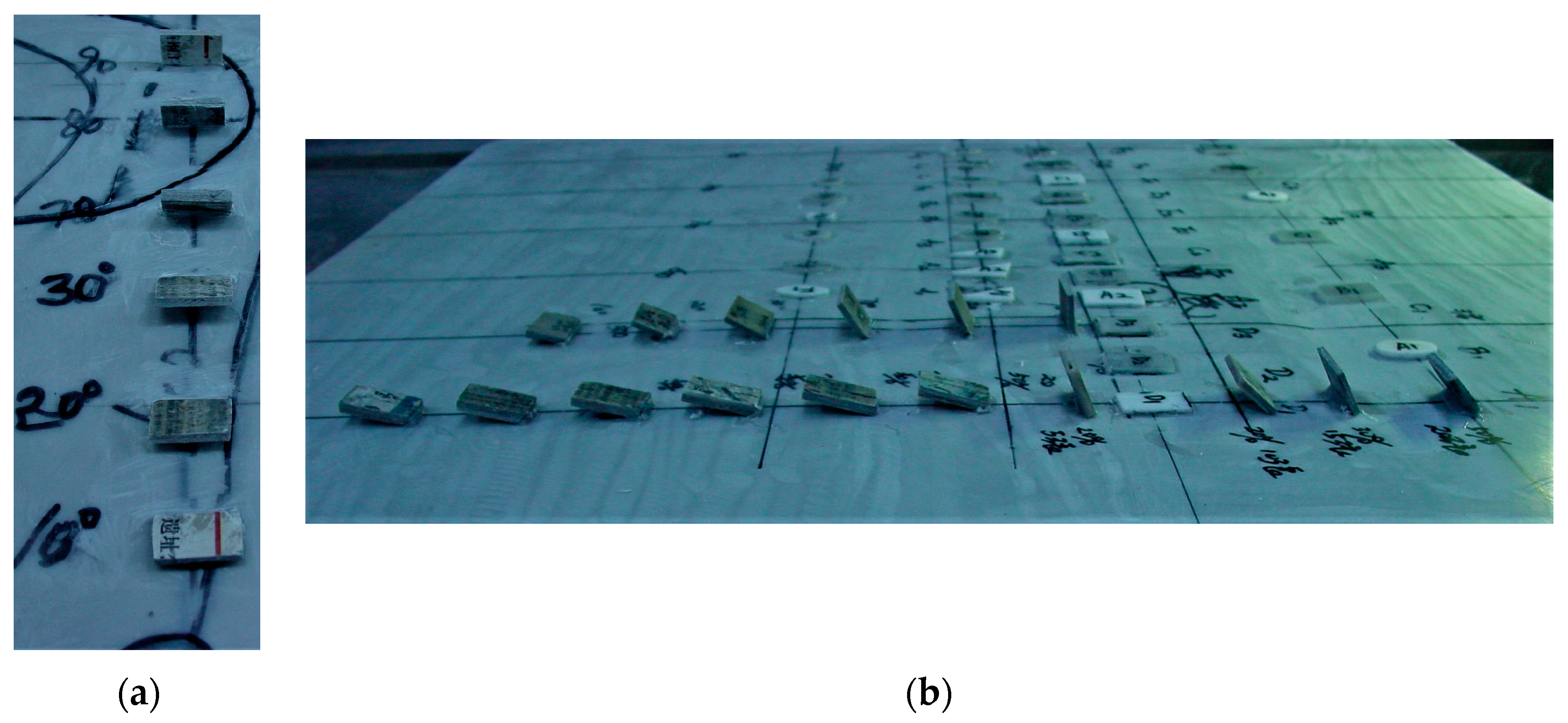

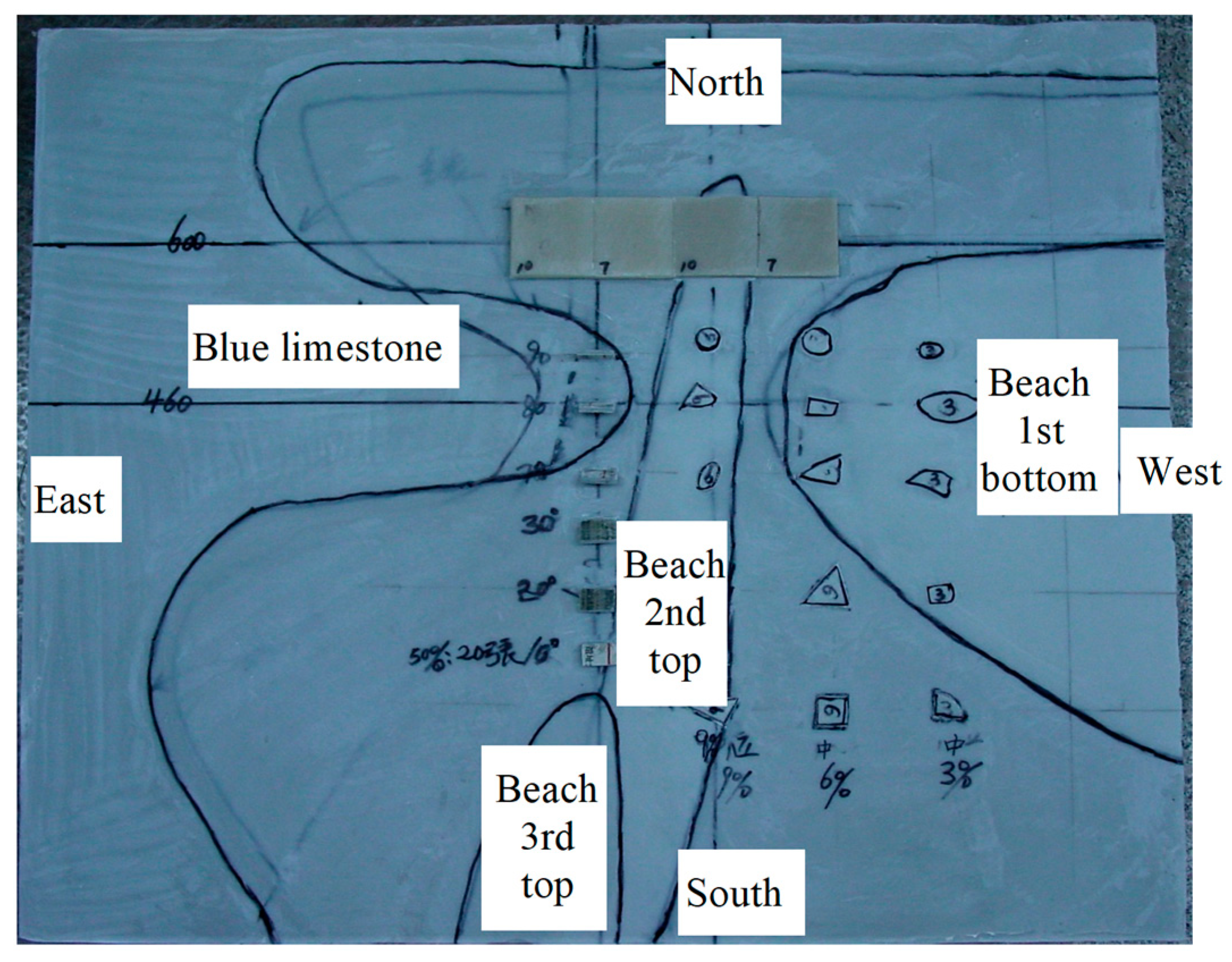
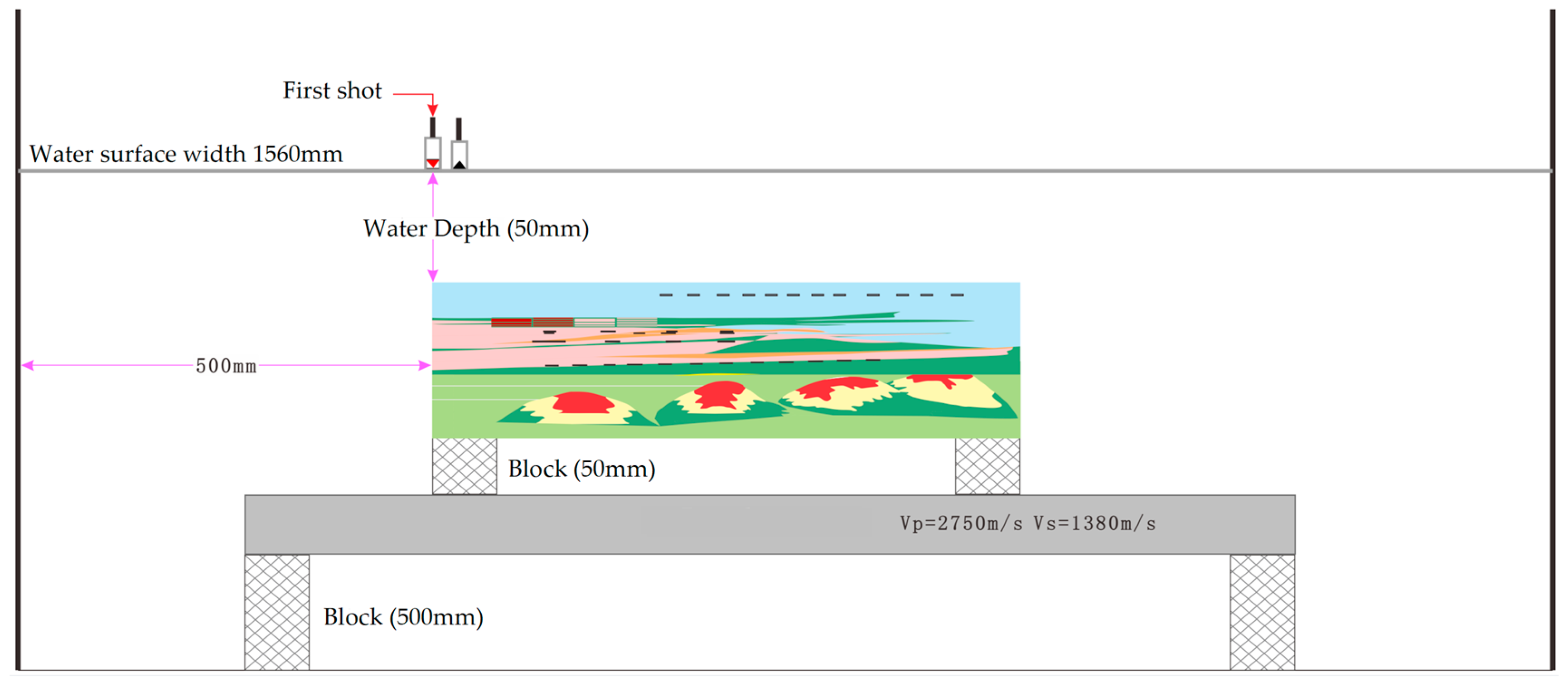
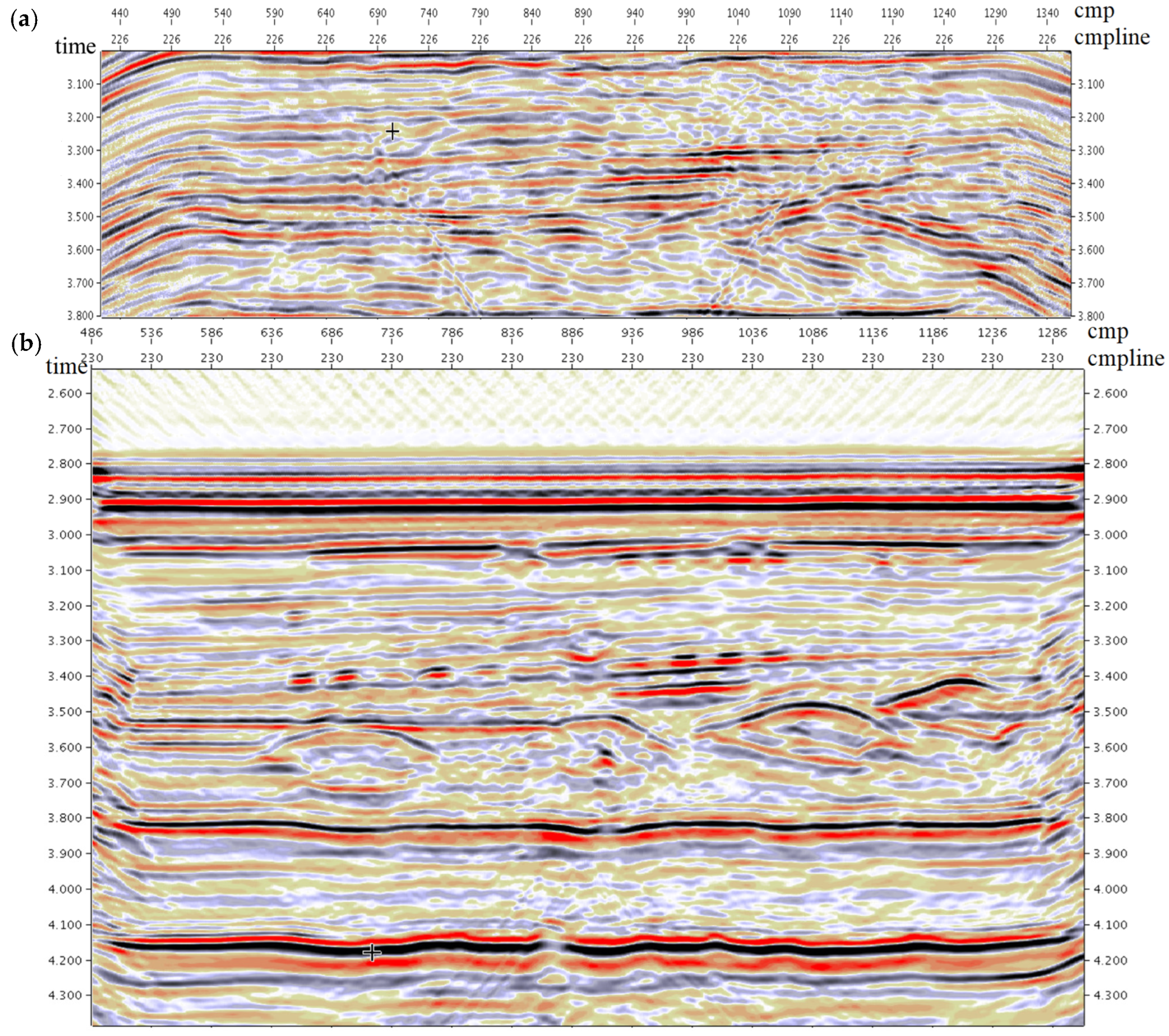

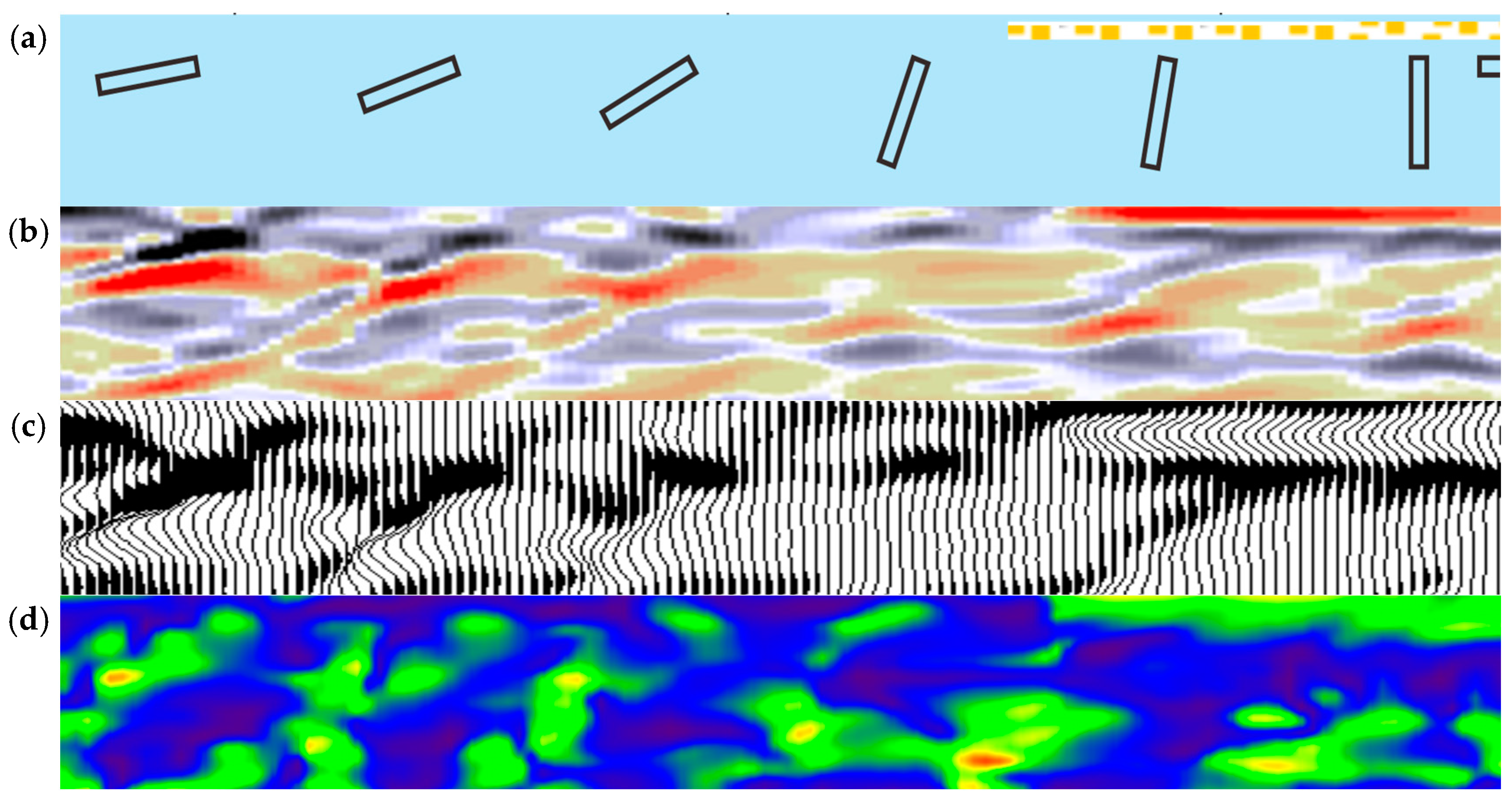
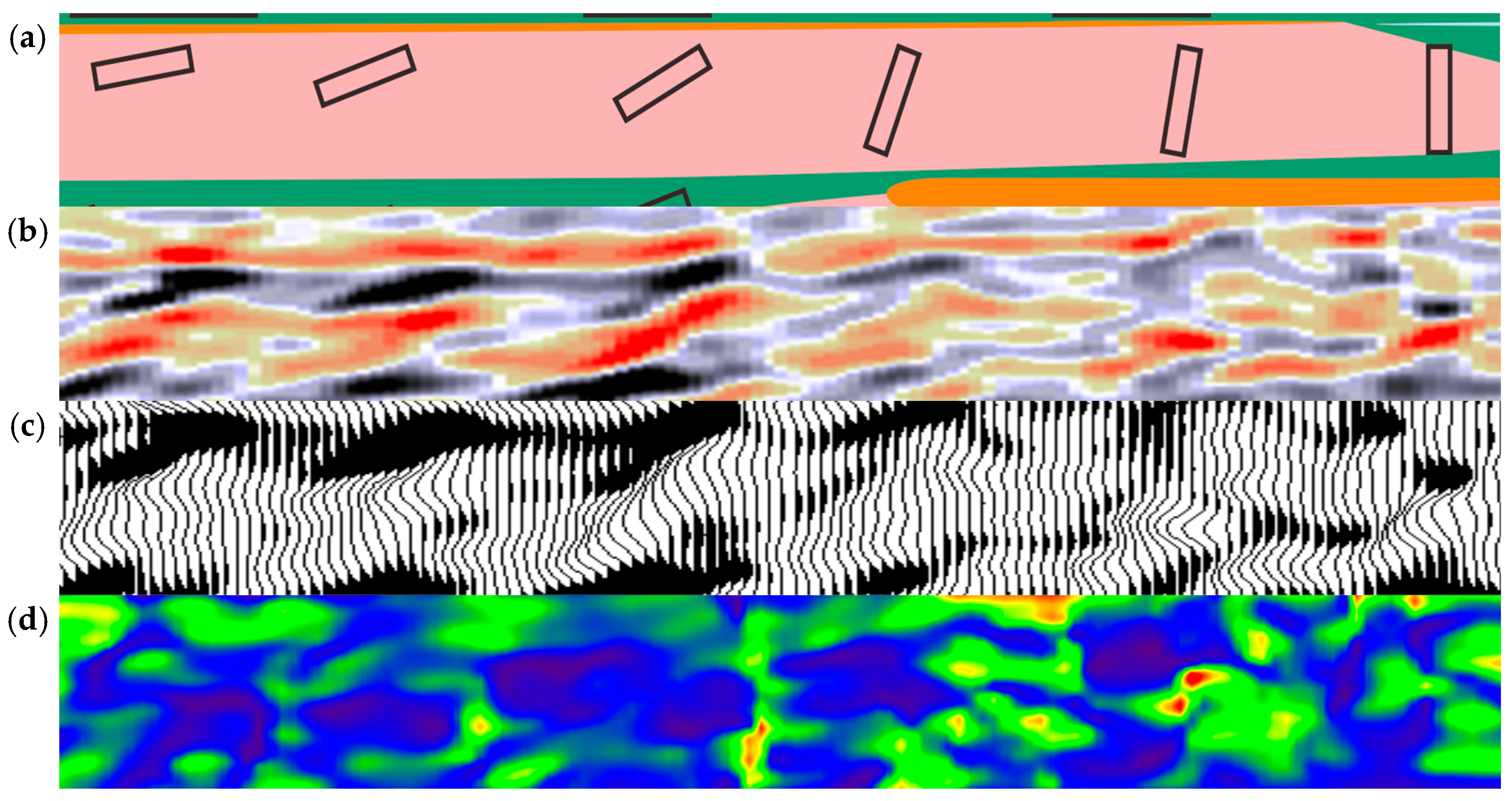
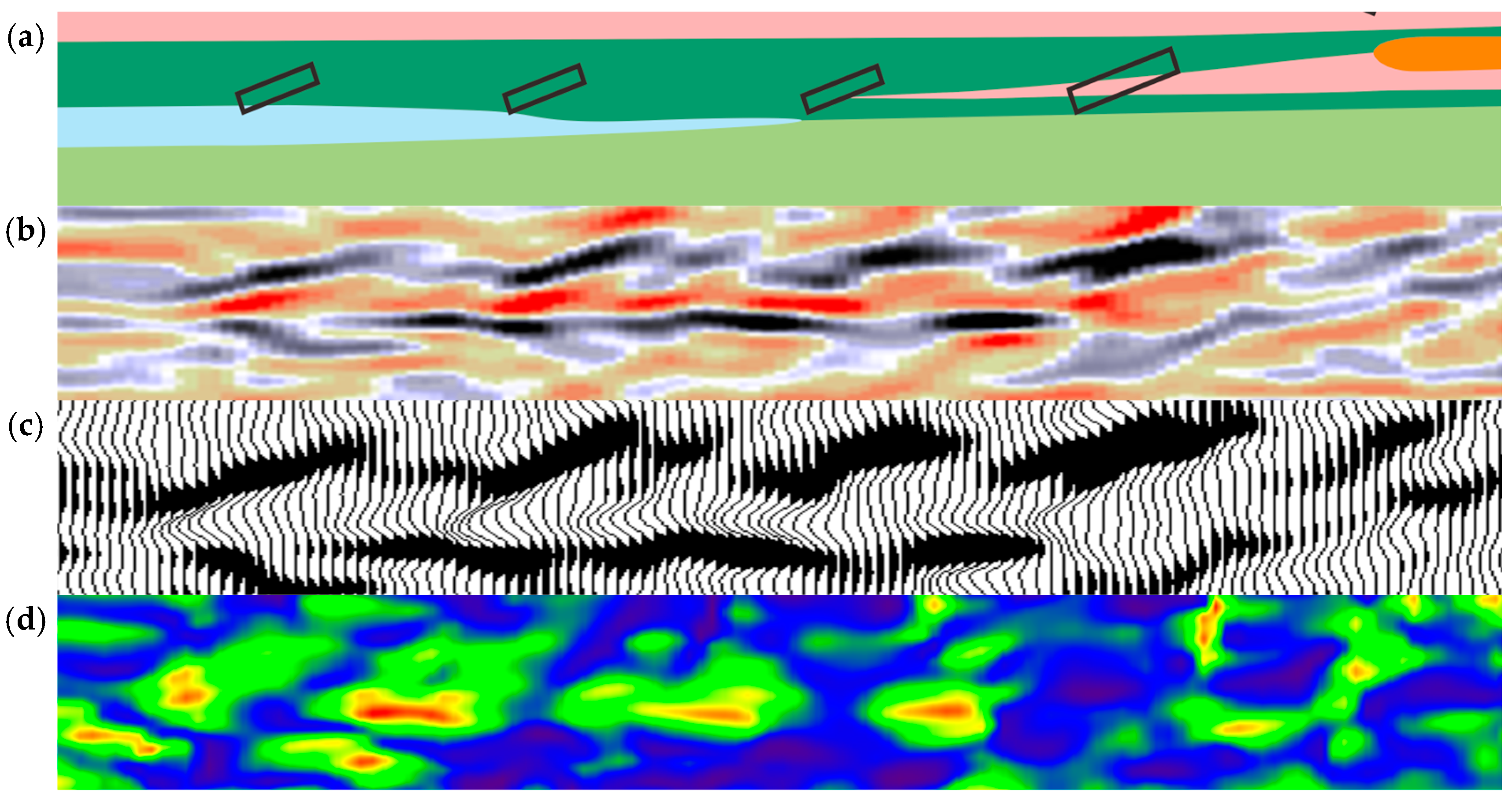
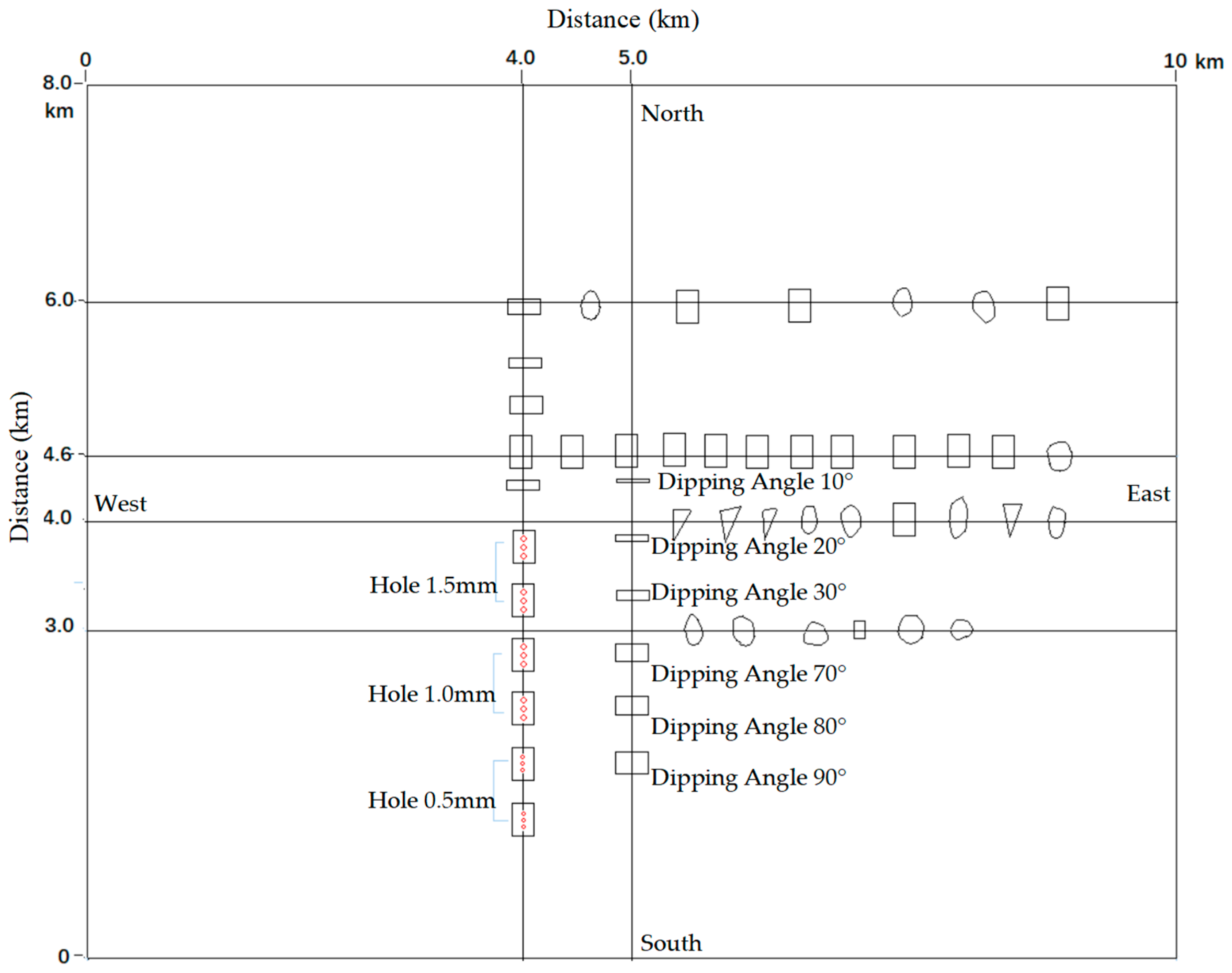
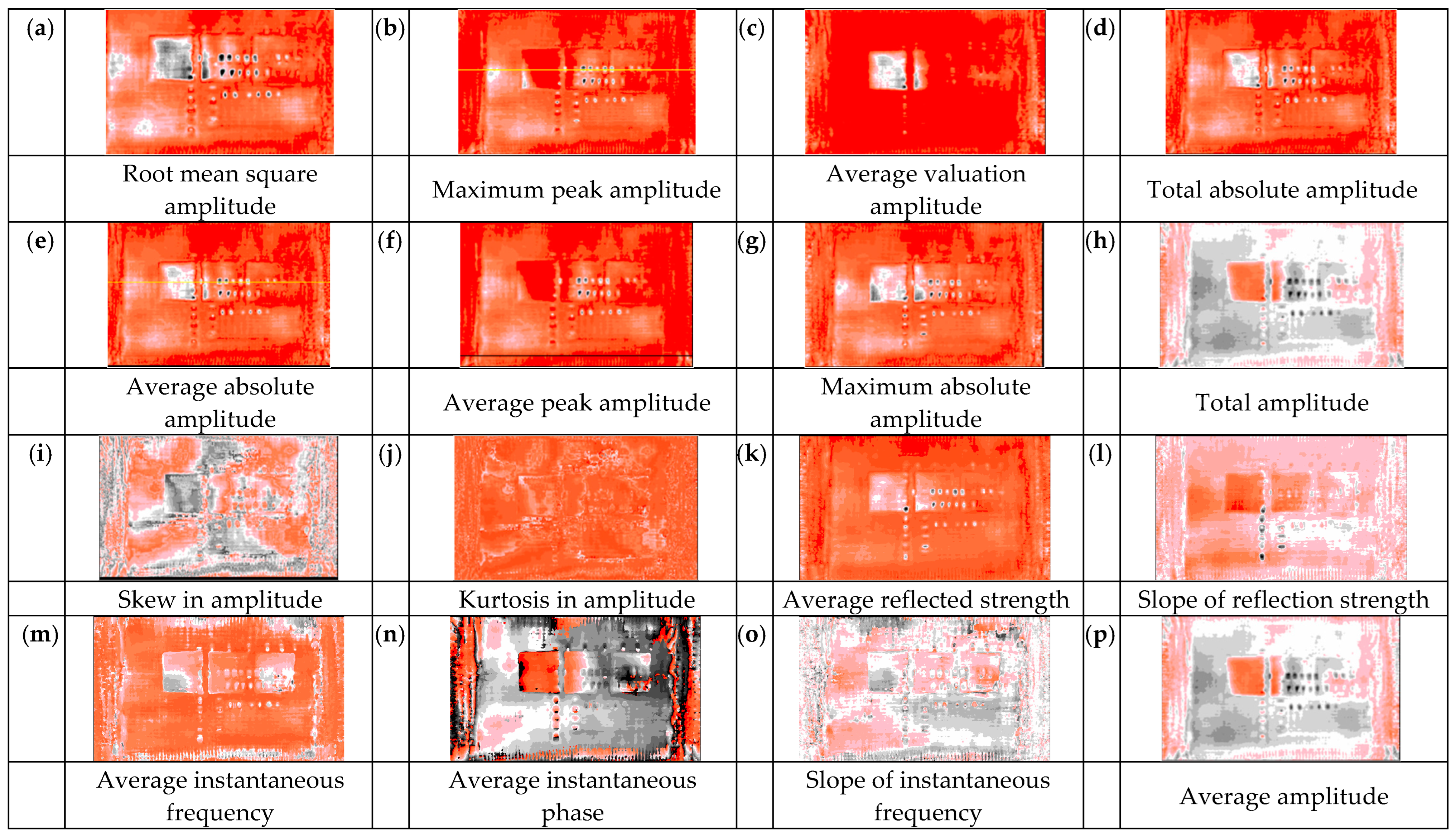
| Fracture | Stratum | Dipping Angle (°) | Fracture Layers | Physical Model | Real Measurement | |||
|---|---|---|---|---|---|---|---|---|
| P-Wave Velocity (m/s) | Density (g/m3) | P-Wave Velocity (m/s) | Density (g/m3) | |||||
| A1 | The top of the Yingshan Formation | Low | 10 | 15 | 2590 | 1.11 | 6216 | 2.03 |
| A2 | 20 | 15 | 2590 | 1.11 | 6216 | 2.03 | ||
| A3 | 30 | 15 | 2590 | 1.11 | 6216 | 2.03 | ||
| A4 | High | 70 | 15 | 2590 | 1.11 | 6216 | 2.03 | |
| A5 | 80 | 15 | 2590 | 1.11 | 6216 | 2.03 | ||
| A6 | 90 | 15 | 2590 | 1.11 | 6216 | 2.03 | ||
| A7 | Low | 0 | 15 | 2590 | 1.11 | 6216 | 2.03 | |
| B1 | The fourth member of the Yingshan Formation | Low | 10 | 20 | 2427 | 1.06 | 5825 | 1.94 |
| B2 | 20 | 20 | 2427 | 1.06 | 5825 | 1.94 | ||
| B3 | 30 | 20 | 2427 | 1.06 | 5825 | 1.94 | ||
| B4 | High | 70 | 20 | 2427 | 1.06 | 5825 | 1.94 | |
| B5 | 80 | 20 | 2427 | 1.06 | 5825 | 1.94 | ||
| B6 | 90 | 20 | 2427 | 1.06 | 5825 | 1.94 | ||
| C1 | The Penglaiba Formation | 20 | 5 | 2479 | 1.12 | 5950 | 2.05 | |
| C2 | 20 | 10 | 2620 | 1.11 | 6288 | 2.03 | ||
| C3 | 20 | 15 | 2590 | 1.11 | 6216 | 2.03 | ||
| C4 | 20 | 20 | 2427 | 1.06 | 5825 | 1.94 | ||
| Physical Model | Geological Model | |
|---|---|---|
| Receiver lines | 23 | 23 |
| Short lines | 29 | 29 |
| Receiver line interval | 35 mm | 350 m |
| Shot line interval | 35 mm | 350 m |
| Trace interval | 2.5 mm | 25 m |
| Shot interval | 5 mm | 50 m |
| Number of traces | 491 | 491 |
| Sampling points | 4096 | 4096 |
| Sampling interval | 0.2 μs | 2 ms |
| Bin | 1.25 × 1.25 mm | 25 × 25 m |
| Dominant frequency | 500 kHz | 25 Hz |
| Number | Dipping Angle | Form | Image | Waveform | Frequency |
|---|---|---|---|---|---|
| A7 | 0° |  |  |  |  |
| A1 | 10° |  |  |  |  |
| A2 | 20° |  |  |  |  |
| A3 | 30° |  |  |  |  |
| A4 | 70° |  |  |  |  |
| A5 | 80° |  |  |  |  |
| A6 | 90° |  |  |  |  |
Disclaimer/Publisher’s Note: The statements, opinions and data contained in all publications are solely those of the individual author(s) and contributor(s) and not of MDPI and/or the editor(s). MDPI and/or the editor(s) disclaim responsibility for any injury to people or property resulting from any ideas, methods, instructions or products referred to in the content. |
© 2024 by the authors. Licensee MDPI, Basel, Switzerland. This article is an open access article distributed under the terms and conditions of the Creative Commons Attribution (CC BY) license (https://creativecommons.org/licenses/by/4.0/).
Share and Cite
Wei, L.; Di, B.; Wei, J. Analysis of Seismic Response Characteristics of Fractured Carbonate Reservoirs Based on Physical Model (Tarim Basin). Appl. Sci. 2024, 14, 3775. https://doi.org/10.3390/app14093775
Wei L, Di B, Wei J. Analysis of Seismic Response Characteristics of Fractured Carbonate Reservoirs Based on Physical Model (Tarim Basin). Applied Sciences. 2024; 14(9):3775. https://doi.org/10.3390/app14093775
Chicago/Turabian StyleWei, Li, Bangrang Di, and Jianxin Wei. 2024. "Analysis of Seismic Response Characteristics of Fractured Carbonate Reservoirs Based on Physical Model (Tarim Basin)" Applied Sciences 14, no. 9: 3775. https://doi.org/10.3390/app14093775
APA StyleWei, L., Di, B., & Wei, J. (2024). Analysis of Seismic Response Characteristics of Fractured Carbonate Reservoirs Based on Physical Model (Tarim Basin). Applied Sciences, 14(9), 3775. https://doi.org/10.3390/app14093775





